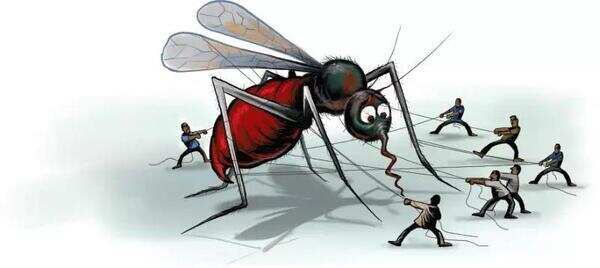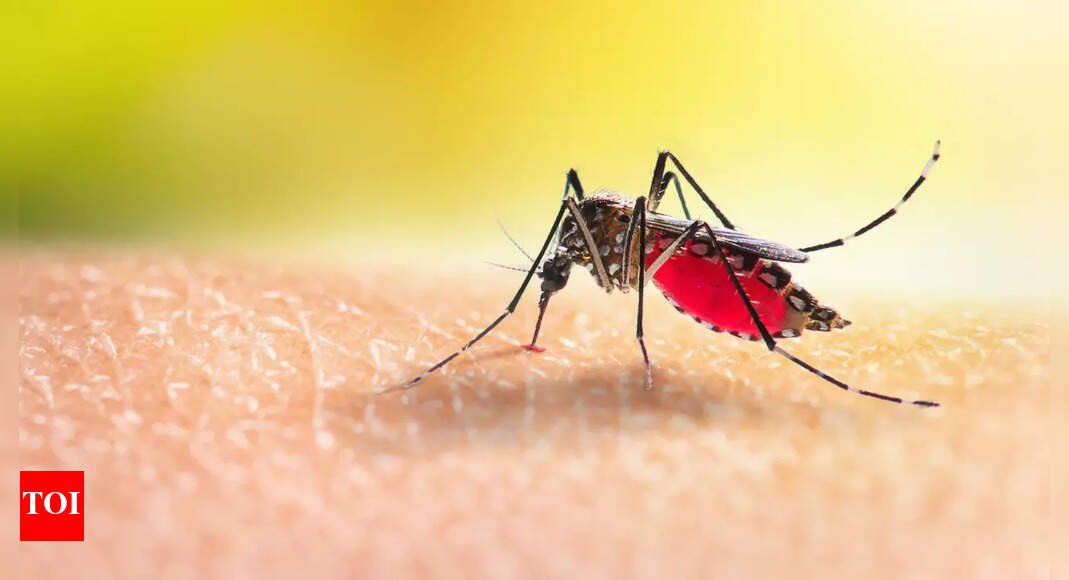Ever wondered why the mosquitoes always seem to find you, even in a room full of people? When a female mosquito is on the hunt for some fresh blood, she has certain preferences, just like you ask the barista for a slim oat milk latte with a shot of vanilla. Yes, mosquitoes are picky. Female mosquitoes pick the human species by tracking our CO2 exhalations, body heat, and body odor. But some people seem to be mosquito magnets than others. Many believe this is due to things like blood type, blood sugar, eating garlic or bananas, or being a woman or child. However, most of these ideas lack strong scientific proof, says Leslie Vosshall, a scientist at Rockefeller Laboratory of Neurogenetics and Behavior.Vosshall and Maria Elena De Obaldia, a former postdoc in her lab, looked at the popular theory to explain varying mosquito appeal: individual odor variations connected to skin microbiota. They found that certain fatty acids emanating from the skin may create a heady perfume that mosquitoes can’t resist. The findings are published in the Cell journal. “There’s a very, very strong association between having large quantities of these fatty acids on your skin and being a mosquito magnet,” Vosshall, the Robin Chemers Neustein Professor at The Rockefeller University and Chief Scientific Officer of the Howard Hughes Medical Institute, said in a statement.
A tournament no one wants to win
To understand the mechanism of this selection, the researchers conducted a three-year study. The eight participants were asked to wear nylon stockings on their forearms for six hours daily, over several days. The worn nylons were then tested against one another in a round-robin style ‘tournament’ using a custom-built plexiglass olfactometer. In each round, mosquitoes were given a choice between two nylons, and researchers observed which one they preferred. They placed Aedes Aegypti mosquitoes, the primary vector species for Zika, dengue, yellow fever, and chikungunya, in the main chamber and observed as the insects flew down the tubes towards one nylon or the other. For Aedes aegypti mosquitoes, the most compelling was Subject 33, who was four times more attractive to the mosquitoes than the next most-attractive study participant, and an astonishing 100 times more appealing than the least attractive, Subject 19.The samples in the trials were anonymous, so researchers didn’t know which participant wore which nylon. Yet, they noticed that something was unusual about Subject 33, because insects would swarm towards that sample. “It would be obvious within a few seconds of starting the assay. It’s the type of thing that gets me really excited as a scientist. This is something real. This is not splitting hairs. This is a huge effect,” De Obaldia said.

The researchers grouped participants into high and low mosquito attractors and looked for what set them apart. Chemical tests revealed 50 compounds that were more common in the skin oil (sebum) of those who attracted more mosquitoes. They also found that these people produced much higher levels of carboxylic acids, substances that skin bacteria use to create unique body odour in humans. To double-check their results, the team ran a second study with 56 new participants. Once again, Subject 33 attracted the most mosquitoes, and continued to do so over time.“Some subjects were in the study for several years, and we saw that if they were a mosquito magnet, they remained a mosquito magnet. Many things could have changed about the subject or their behaviors over that time, but this was a very stable property of the person,” De Obaldia added.
What’s the science behind
Humans produce two classes of odors that mosquitoes detect with two different sets of odor receptors: Orco and IR receptors. To test whether they could make mosquitoes that couldn’t detect humans, researchers created genetically modified mosquitoes missing one or both key scent receptors. The orco mutants remained attracted to humans and were able to distinguish between mosquito magnets and low attractors, while IR mutants lost their attraction to humans to a varying degree, but still retained the ability to find humans.“The goal was a mosquito that would lose all attraction to people, or a mosquito that had a weakened attraction to everybody and couldn’t discriminate Subject 19 from Subject 33. That would be tremendous. And yet that was not what we saw. It was frustrating,” Vosshall added.These findings support another study by Vosshall, which showed how complex and reliable the mosquito’s sense of smell is. Female Aedes aegypti mosquitoes depend on blood to survive and reproduce, so their scent-detection system has multiple backups to make sure they can always find a human host. “Without blood, she can’t do either. That’s why she has a backup plan and a backup plan and a backup plan and is tuned to these differences in the skin chemistry of the people she goes after,” Vosshall says.Mosquitoes have such a strong sense of smell that it’s hard to imagine they’ll ever stop targeting humans. However, one possible solution is to change the bacteria on our skin. For example, covering the skin of someone who attracts lots of mosquitoes (like Subject 33) with skin oils and bacteria from someone who doesn’t (like Subject 19) might help hide them from mosquitoes.
“We haven’t done that experiment. That’s a hard experiment. But if that were to work, then you could imagine that by having a dietary or microbiome intervention where you put bacteria on the skin that are able to somehow change how they interact with the sebum, then you could convert someone like Subject 33 into a Subject 19. But that’s all very speculative,” Vosshall added.
var _mfq = window._mfq || [];
_mfq.push([“setVariable”, “toi_titan”, window.location.href]);
!(function(f, b, e, v, n, t, s) {
function loadFBEvents(isFBCampaignActive) {
if (!isFBCampaignActive) {
return;
}
(function(f, b, e, v, n, t, s) {
if (f.fbq) return;
n = f.fbq = function() {
n.callMethod ? n.callMethod(…arguments) : n.queue.push(arguments);
};
if (!f._fbq) f._fbq = n;
n.push = n;
n.loaded = !0;
n.version = ‘2.0’;
n.queue = [];
t = b.createElement(e);
t.async = !0;
t.defer = !0;
t.src = v;
s = b.getElementsByTagName(e)[0];
s.parentNode.insertBefore(t, s);
})(f, b, e, ‘https://connect.facebook.net/en_US/fbevents.js’, n, t, s);
fbq(‘init’, ‘593671331875494’);
fbq(‘track’, ‘PageView’);
};
function loadGtagEvents(isGoogleCampaignActive) {
if (!isGoogleCampaignActive) {
return;
}
var id = document.getElementById(‘toi-plus-google-campaign’);
if (id) {
return;
}
(function(f, b, e, v, n, t, s) {
t = b.createElement(e);
t.async = !0;
t.defer = !0;
t.src = v;
t.id = ‘toi-plus-google-campaign’;
s = b.getElementsByTagName(e)[0];
s.parentNode.insertBefore(t, s);
})(f, b, e, ‘https://www.googletagmanager.com/gtag/js?id=AW-877820074’, n, t, s);
};
function loadSurvicateJs(allowedSurvicateSections = []){
const section = window.location.pathname.split(‘/’)[1]
const isHomePageAllowed = window.location.pathname === ‘/’ && allowedSurvicateSections.includes(‘homepage’)
if(allowedSurvicateSections.includes(section) || isHomePageAllowed){
(function(w) {
function setAttributes() {
var prime_user_status = window.isPrime ? ‘paid’ : ‘free’ ;
var geoLocation = window?.geoinfo?.CountryCode ? window?.geoinfo?.CountryCode : ‘IN’ ;
w._sva.setVisitorTraits({
toi_user_subscription_status : prime_user_status,
toi_user_geolocation : geoLocation
});
}
if (w._sva && w._sva.setVisitorTraits) {
setAttributes();
} else {
w.addEventListener(“SurvicateReady”, setAttributes);
}
var s = document.createElement(‘script’);
s.src=”https://survey.survicate.com/workspaces/0be6ae9845d14a7c8ff08a7a00bd9b21/web_surveys.js”;
s.async = true;
var e = document.getElementsByTagName(‘script’)[0];
e.parentNode.insertBefore(s, e);
})(window);
}
}
window.TimesApps = window.TimesApps || {};
var TimesApps = window.TimesApps;
TimesApps.toiPlusEvents = function(config) {
var isConfigAvailable = “toiplus_site_settings” in f && “isFBCampaignActive” in f.toiplus_site_settings && “isGoogleCampaignActive” in f.toiplus_site_settings;
var isPrimeUser = window.isPrime;
var isPrimeUserLayout = window.isPrimeUserLayout;
if (isConfigAvailable && !isPrimeUser) {
loadGtagEvents(f.toiplus_site_settings.isGoogleCampaignActive);
loadFBEvents(f.toiplus_site_settings.isFBCampaignActive);
loadSurvicateJs(f.toiplus_site_settings.allowedSurvicateSections);
} else {
var JarvisUrl=”https://jarvis.indiatimes.com/v1/feeds/toi_plus/site_settings/643526e21443833f0c454615?db_env=published”;
window.getFromClient(JarvisUrl, function(config){
if (config) {
const allowedSectionSuricate = (isPrimeUserLayout) ? config?.allowedSurvicatePrimeSections : config?.allowedSurvicateSections
loadGtagEvents(config?.isGoogleCampaignActive);
loadFBEvents(config?.isFBCampaignActive);
loadSurvicateJs(allowedSectionSuricate);
}
})
}
};
})(
window,
document,
‘script’,
);
#people #mosquito #magnets #turns #reason



